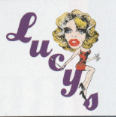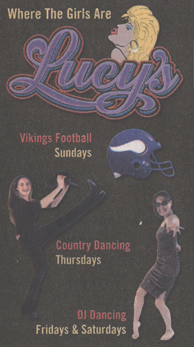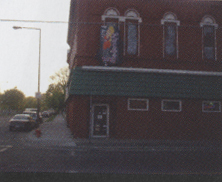Difference between revisions of "Lucy's"
m (Protected "Lucy's" [edit=sysop:move=sysop]) |
|||
| (10 intermediate revisions by one other user not shown) | |||
| Line 1: | Line 1: | ||
| − | + | <div style="text-align: center;"> | |
| + | '''601 N. western Avenue, St. Paul (2000-2004)''' | ||
| + | </div> | ||
| + | |||
| + | |||
| + | |||
| + | {| {{prettytable}} | ||
| + | ! | ||
| + | ! | ||
| + | |- | ||
| + | | [[Image:Svc_lucy's.jpg]] | ||
| + | | St. Paul’s [[Grand Avenue]] and West Seventh Street maintained persistent queer populations even after the city lost equal rights between 1978 and 1993. In that time, the city’s old gay and lesbian settlements had become overpriced (in the case of Grand) and overpopulated (in the case of West Seventh).<small>(1)</small> After 1993, many queer newcomers settled in other (and more affordable) tract of the city. | ||
| + | |} | ||
| + | {| {{prettytable}} | ||
| + | ! | ||
| + | ! | ||
| + | |- | ||
| + | | Namely, the populations settled in the city’s North End district and Frogtown Neighborhoods. Traditionally settled by Canadian French (hence “Frogs”) and Irish working-class groups<small>(3)</small>—and recently by southeast Asian immigrants—the section is home to historic sites of queer interest such as Marydale Park and Shades of Yellow (SOY). | ||
| + | |||
| + | |||
| + | |||
| + | |||
| + | “Lucy’s Saloon” opened in 2000; it was a manifestation of the queer population’s slow growth over the past decade. The bar served a predominantly lesbian clientele, and it is especially notable for an altercation with the St. Paul Police. On Saturday night in the fall of 2003, Sgt. Jon Loretz got into a physical altercation with the bar’s patrons when the off-duty officer’s female companion got into an argument with another woman.<small>(4)</small> | ||
| + | | | ||
| + | <div style="text-align: center;"> | ||
| + | [[Image:Svc_lucy'sad.jpg]] | ||
| + | </div> <div style="text-align: center;">'''<small>Lucy's ad in [[Lavender Magazine]], courtesy of the [[Jean-Nickolaus Tretter Collection]].</small>''' | ||
| + | </div> | ||
| + | |} | ||
| + | |||
| + | |||
| + | |||
| + | {| {{prettytable}} | ||
| + | ! | ||
| + | ! | ||
| + | |- | ||
| + | | <div style="text-align: center;"> | ||
[[Image:Svc_lucy's2.jpg]] | [[Image:Svc_lucy's2.jpg]] | ||
| + | </div> <div style="text-align: center;"> | ||
| + | <small>'''The Exterior of Lucy's in 2001. From the Twin Cities Pride guide, courtesy of the [[Jean-Nickolaus Tretter Collection]].'''</small> | ||
| + | </div> | ||
| + | | The sergeant, who did not explain his police status, sent two women to the hospital and reportedly threw homophobic insults at staff.<small>(5)</small> Loretz’s father was police chief at the time, and the altercation failed to terminate the Sergeant’s employment—he was never charged with any wrongdoing. <small>(6)</small> | ||
| − | + | ||
| + | Crime sullied the site again in 2004; Lucy’s closed shortly after a man was shot dead while intervening in a heated argument. The historic tavern—once a venue for John Lee Hooker, Etta James, and Willie Dixon—was targeted by Frogtown resident in 2009,<small>(7)</small> when a second murder took place outside of the “Moonlight Magic Bar” at the intersection of Western Avenue and Thomas. | ||
| + | |} | ||
| Line 9: | Line 51: | ||
| − | + | <small>(1)</small> Tretter, Jaen-Nickolaus. Interview with the author, 3/26/10 | |
| + | |||
| + | <small>(2)</small> ''Ibid.'' | ||
| + | |||
| + | <small>(3)</small> Young Huie, Wing. ''Frogtown: Photographs and Conversations in an Urban Neighborhood.'' St. Paul: Minnesota Historical Society Press, 1996. Page 1. | ||
| + | |||
| + | <small>(4)</small> Pina, Phillip. "Police Chief's Son Part of Inquiry: BCA to Prove Bar Brawl That Witnesses Say Was Started by Off-Duty Officer," ''The St. Paul Pioneer Press,'' 10/21/2003. Front page. | ||
| + | |||
| + | <small>(5)</small> ''Ibid.'' | ||
| + | |||
| + | <small>(6)</small> ''Ibid.'' | ||
| + | |||
| + | <small>(7)</small> Giles, Kevin. "After Crimes, Frogtown Residetns Want Bar Closed." ''The Minneapolis Star-Tribune,'' 5/12/2009. http://www.startribune.com/local/stpaul/44755087.html?page=1&c=y | ||
Part of [[Minneapolis/St. Paul, MN: 100 Queer Places in Minnesota History, (1860-1969), (1969-2010)]] | Part of [[Minneapolis/St. Paul, MN: 100 Queer Places in Minnesota History, (1860-1969), (1969-2010)]] | ||
Latest revision as of 11:24, 1 May 2010
601 N. western Avenue, St. Paul (2000-2004)

|
St. Paul’s Grand Avenue and West Seventh Street maintained persistent queer populations even after the city lost equal rights between 1978 and 1993. In that time, the city’s old gay and lesbian settlements had become overpriced (in the case of Grand) and overpopulated (in the case of West Seventh).(1) After 1993, many queer newcomers settled in other (and more affordable) tract of the city. |
| Namely, the populations settled in the city’s North End district and Frogtown Neighborhoods. Traditionally settled by Canadian French (hence “Frogs”) and Irish working-class groups(3)—and recently by southeast Asian immigrants—the section is home to historic sites of queer interest such as Marydale Park and Shades of Yellow (SOY).
|
Lucy's ad in Lavender Magazine, courtesy of the Jean-Nickolaus Tretter Collection.
|
| The Exterior of Lucy's in 2001. From the Twin Cities Pride guide, courtesy of the Jean-Nickolaus Tretter Collection. |
The sergeant, who did not explain his police status, sent two women to the hospital and reportedly threw homophobic insults at staff.(5) Loretz’s father was police chief at the time, and the altercation failed to terminate the Sergeant’s employment—he was never charged with any wrongdoing. (6)
|
(1) Tretter, Jaen-Nickolaus. Interview with the author, 3/26/10
(2) Ibid.
(3) Young Huie, Wing. Frogtown: Photographs and Conversations in an Urban Neighborhood. St. Paul: Minnesota Historical Society Press, 1996. Page 1.
(4) Pina, Phillip. "Police Chief's Son Part of Inquiry: BCA to Prove Bar Brawl That Witnesses Say Was Started by Off-Duty Officer," The St. Paul Pioneer Press, 10/21/2003. Front page.
(5) Ibid.
(6) Ibid.
(7) Giles, Kevin. "After Crimes, Frogtown Residetns Want Bar Closed." The Minneapolis Star-Tribune, 5/12/2009. http://www.startribune.com/local/stpaul/44755087.html?page=1&c=y
Part of Minneapolis/St. Paul, MN: 100 Queer Places in Minnesota History, (1860-1969), (1969-2010)

